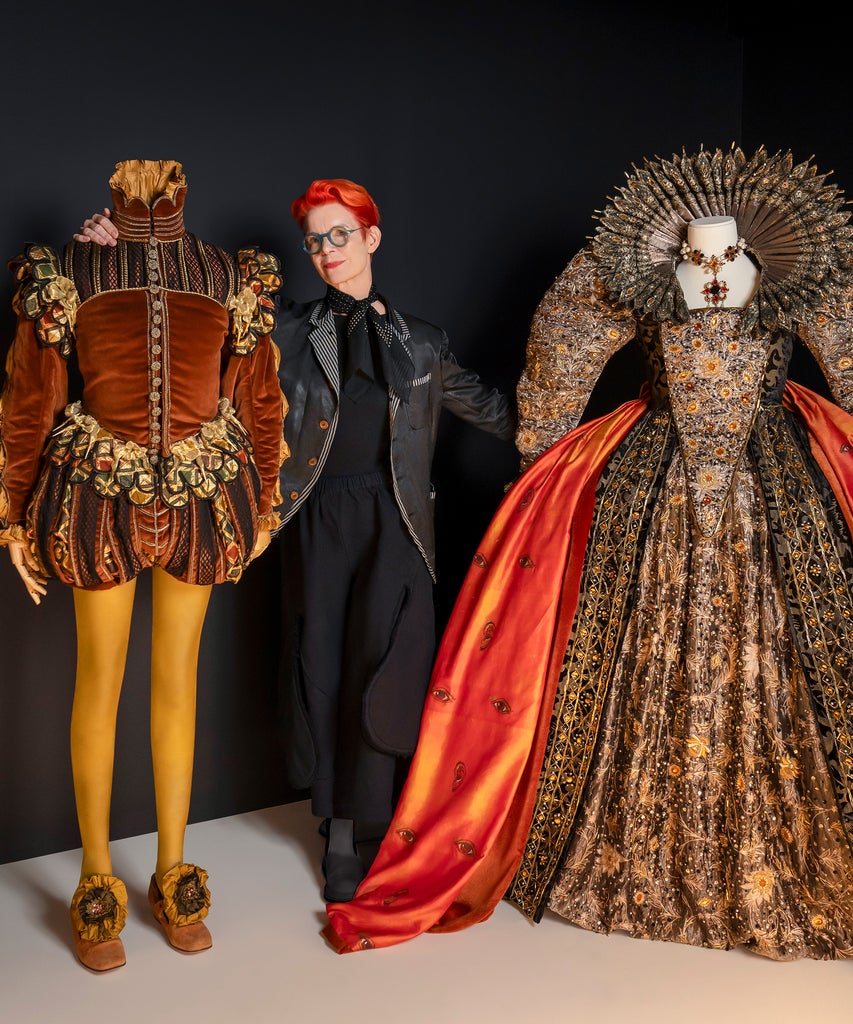“Some films you like because you love the end product, and other films you like because you had the best time making them,” award-winning costume designer Sandy Powell tells Refinery29 just hours before the opening of her first-ever retrospective at SCAD Fash Museum of Fashion and Film in Atlanta. From Shakespeare In Love, The Aviator, and Young Victoria (which earned Powell Best Costume Design Oscar wins) to Velvet Goldmine and The Favourite (for which she won BAFTAs) and Gangs of New York and Carol (for which she has been nominated for), Powell has worked on some of the most visually stunning costumes of the past 40 years. Now, “Sandy Powell’s Dressing the Part: Costume Design for Film” exhibit celebrates Powell’s contributions to the cinematic canon — which have been recognized with 15 Academy Awards and 16 British Academy Awards! — with 125 costumes on display.
“A huge number of the costumes are from my own archive, and it’s been strange seeing them all exhibited on mannequins because, for the last 20,30 years, they’ve been on hangers on racks in a garage,” she said at the panel, hosted by Savannah College of Art and Design to celebrate the opening, a few hours later. “I’m amazed they’re still in one piece.”
The exhibit begins with looks from Powell’s earliest costume work — Caravaggio (1986), her first film, and Orlando (1993), the first feature she was nominated for — to her more recent projects like The Irishman. Some of the visual standouts include the dress that 11-year-old Kirsten Dunst wore in Interview with the Vampire and Jonathan Rhys Myers’ glam-rock looks from Velvet Goldmine that have been in and out of costume rental companies for the last 25-plus years (which Powell notes is the reason why the costumes look “a little bit worn”). The literal jewel of the room is the ballgown worn by Lily James in Disney’s 2015 live-action remake of Cinderella which required a team of 20 people, 550 hours, 10,000 Swarovski crystals, and 270 yards of fabric to make, the latter of which earned a Guinness World Record. (Powell’s work on Robert De Niro’s wardrobe in The Irishman also had a record number of costume changes, though she jokingly hesitates to take credit: “That’s a testament to [De Niro] because imagine having how many fittings he had to have?!”)
Ahead, some of the other highlights from “Sandy Powell’s Dressing the Part: Costume Design for Film,” which runs until March 16, 2025.
Shakespeare in Love (1998)
SCAD Atlanta – Fall 2024 – Exhibitions – Sandy Powell – ”Sandy Powell: Dressing the Part” – Teaser Documentation – SCAD Fash – Photography Courtesy of SCAD
At the same time as Powell was working on the fashion for Shakespeare In Love, friend and fellow costume designer Alexandra Byrne was creating costumes for Elizabeth. “It was interesting,” she says. “We were both designing Elizabethan [-era looks], but in a different way. Alex was doing the serious one and I was doing the comedy version, but, I think, we went through the same process — researching the period and making the clothes as historically accurate as we could do it. But I had a little bit more artistic license to sort of exaggerate.”
The ball gowns on display, worn by Judi Dench and Gwyneth Paltrow, make clear early on in the exhibit why Powell has gone on to be nominated an astounding number of times over the course of her career. “They’re kind of works of structural engineering. I mean, to actually make something this shape and for it to maintain its silhouette [so many years after], it’s pretty clever. It’s a testament to the costume makers that work with me.” But while intricate adornments and embellishments cover every inch of the dresses, Powell is quick to point out that “a lot of it is cheating, a lot of it is glued on.”
While Shakespeare in Love marked Powell’s first Oscar win, she says it was a bittersweet moment: “I had nominations for both Shakespeare in Love and Velvet Goldmine at the same time which was really difficult. Everybody thinks, Oh my God, you’re so lucky, you’re gonna win. No, you half your chance of winning!”
And while, on the surface, Shakespeare in Love, which is set in the 16th century and follows the fictional love story of William Shakespeare, is very different from Velvet Goldmine, Powell says that the “glitz and glamour” is not unlike the one she tried to portray in the film that kick-started her collaboration with Todd Haynes and captured the glam rock era of the 1970s. “It was such a great atmosphere on set. We were making Velvet Goldmine and kind of re-living the era,” she says.
Gangs of New York (2002)
SCAD Atlanta – Fall 2024 – Exhibitions – Sandy Powell – ”Sandy Powell: Dressing the Part” – Teaser Documentation – SCAD Fash – Photography Courtesy of SCAD
The film that began Powell’s longtime partnership with director Martin Scorsese (the costume designer also worked on The Aviator, Shutter Island, Hugo, The Wolf of Wall Street, and The Irishman), Gangs of New York saw Powell painting the fabrics to include vibrant greens, blues, and reds in an otherwise dark story set in the Five Points slum in Manhattan in the mid-19th century. “In period films about poorer people, which is what these characters are, they are always in brown tones. As if people just wore brown in the olden days; of course, they didn’t. And I was interested in having things that would have started as strong, bold colors and sort of faded and got worn away and worn out,” she says.
With that in mind, every costume featured in the film was sent to the dyeing department. “I use paint on most of the costumes… to give depth and turn to things and also make things look a little bit worn. So, everything isn’t just one flat color,” she says. “Scorsese wanted us to create a world. It was a sort of an invented world that was based on a real place in real time,” says Powell.
Powell also looked to unusual fabric sources to create costumes for the characters, including a coat that Daniel Day-Lewis’ character wears: “One day, my shopper who was getting fabric swatches came in and she threw this massive great big thing on the floor in my office, and it was this old, smelly thing, and I was like, ‘What’s that?!’ And she was like, ‘It’s an army tent! I thought it might be useful.’ And then we started pulling it apart and looked at it and it’s such a great texture.”
Powell’s penchant for color and texture similarly came through in Mary Poppins Returns, the 2018 sequel to the 1964 Disney classic, which holds a special place in Powell’s heart because it was the first film she remembers seeing as a child. “When I was asked if I wanted to do it, I was like, ‘Of course, that would be great fun!’ And then it was quite scary thinking… You’ve got the first one to live up to! And so it was honoring the first one, yet doing it differently.”
For a scene that references the “Supercalifragilisticexpialidocious” number in the original, that stars Julie Andrews and Dick Van Dyke against a background of animated characters, Powell, made the actors’ costumes appear like 2-D cut-outs thanks to a painting technique. “Because the [original film] is from the ‘60s, it’s really obvious that it’s 3-D people against the animation, which is sweet but I thought, Wouldn’t it be great to make the 3-D people look like they are part of the animation? So I wanted to paint them in the same way as the animated characters would be painted. And have them look flat.”
Carol (2015)
SCAD Atlanta – Fall 2024 – Exhibitions – Sandy Powell – ”Sandy Powell: Dressing the Part” – Teaser Documentation – SCAD Fash – Photography Courtesy of SCAD
While most of the looks from the exhibit are the original pieces and multiples that Powell used on the film sets, there was a piece that had to be recreated for the show — and it’s arguably one of the costume designer’s most recognizable works: the fur coat worn by Cate Blanchett’s Carol character.
To create the perfect shade of brown for Blanchett in an authentic-for-the-time material, Powell — who never uses new fur in any of her costume work — pieced the look together from bits of vintage coats. “I just knew it had to be a pale kind of coat, and I couldn’t find the right shape in the right period in the right color,” she explains. Because of the Frankenstein-esque design process, the piece was “extremely fragile” to wear.
While Powell prepared an alternate option, in a darker hue, for the screen test, after presenting it to Haynes — whom, in addition to Velvet Goldmine, Powell previously worked with on Far From Heaven — she opted for the original one. “I made the decision to risk it. It could have been absolutely disastrous,” she says. While the coat “split every single day of the shoot” and had to be sewn and taped together multiple times, it didn’t fully fall apart until post-filming when it was sent to the cleaners.
How to Talk to Girls at Parties (2017)
SCAD Atlanta – Fall 2024 – Exhibitions – Sandy Powell – ”Sandy Powell: Dressing the Part” – Teaser Documentation – SCAD Fash – Photography Courtesy of SCAD
When working on John Cameron Mitchell’s How to Talk to Girls at Parties, which stars Elle Fanning as an alien visiting London in the ‘70s, Powell got to envision the future while simultaneously looking to the past. “It was a fun one to do… I found the concept of aliens in the 1970s interesting,” she says. “It’s set a little bit later than Velvet Goldmine but is a whole different aesthetic. It’s a punk aesthetic, as opposed to the glam rock aesthetic.” That is made visually obvious for visitors, with vignettes from the two films sharing the same wall in the exhibit.
To bring the punk aesthetic to life, in addition to vinyl, Powell used latex. “This was one of the hardest pieces to display [at the museum] because, to get latex onto a human body, you have to silicone your body first,” she says. “But we’re not pulling it onto skin, we’re putting it onto the fabric-covered legs.”
While agreeing that it was challenging, Rafael Gomez, creative director of SCAD Fash, also noted that the museum is thrilled to have the pieces from the film on display from an “archival point of view” as latex isn’t a long-lasting material. “The looks will start liquefying and melting with time,” Gomez says. “We are very proud to have them here now because they might not be exhibited in the future.”
The Favourite (2018)
SCAD Atlanta – Fall 2024 – Exhibitions – Sandy Powell – ”Sandy Powell: Dressing the Part” – Teaser Documentation – SCAD Fash – Photography Courtesy of SCAD
While color plays a “very, very important” role in most of Powell’s work, with a tight pre-production time and budget for Yorgos Lanthimos’ The Favourite, she opted out of having a dye department. “I rarely use the fabric as it comes out of a store. I always need to change it a bit to the color that’s in my head, and it takes up a lot of time,” she says. Inspired by the 1982 Peter Greenaway film The Draughtsman’s Contract, which was set in a similar time, Powell opted for a limited color palette. “Doing black-and-white costumes was quite interesting because I’m obsessed with color,” she says. “By eliminating the color from The Favourite, it gave me more time to think about other things.”
She used that time to source cheap fabrics like cotton for Olivia Colman’s Queen Anne and her court attendants and denim for servants including Emma Stone’s maid character. “I thought, Let’s simplify it. Let’s strip it right down to the bare bones. So the idea was to keep the silhouette historically accurate but change the materials they were made from,” she says. “For all the corsets, I just went to thrift stores and bought jeans, and they were just cut up. I decided to [dress] all the servants in, like, workwear fabric.”
She also chose to strip the costumes of the adornments that would be typical of a queen’s court at the beginning of the 18th century. “In this period, it would have been really sumptuous and rich. The courtiers would be covered in embellishment and jewels and embroidery,” says Powell. “I thought, There’s no way we’re going to be able to afford to make those costumes, and we don’t actually have the time to make those costumes.” With that in mind, the only decoration used was laser-cut fabric. “I was in a cheap fabric store in London, and I saw a roll of laser-print vinyl, and we just cut it into strips and glued them on,” she says. “The black-and-white looked quite sophisticated and left space for the wild dialogue… without it being all about the clothes.”
Like what you see? How about some more R29 goodness, right here?







